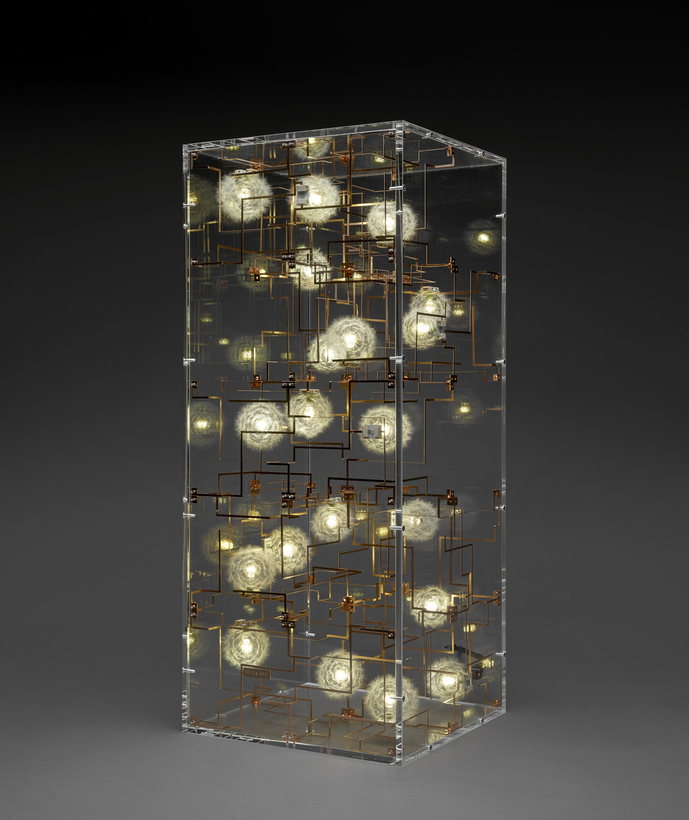The first time I was beguiled by a lamp came courtesy of Cary Grant and Audrey Hepburn. The movie was Charade (1963), and the lamp was an Art Nouveau number placed next to the phone in Hepburn’s hotel room. It is simple and elegant, dark bronze and opaque glass. The stem of the lamp divides at the top like a Y and then each branch curves symmetrically downward into two elongated and glowing shades, making an M.
In Charade, Hepburn is a woman webbed between battling men. The lamp in her room is as slim and graceful as she is, female and rather fallopian. Well, Art Nouveau is feminine, a curvaceous meeting of Orientalist languor, European desire, and missives from Mother Nature. The first time the camera cuts to that lamp, it has moved straight from the faces of Grant and Hepburn, a close-up of him consoling her, and the echo of their two heads in those two shades suggests the couple they will become. I still thrill to that lamp when I re-watch the movie.
The movie was Charade, and the lamp was an Art Nouveau number placed next to the phone in Audrey Hepburn’s hotel room.
It was a monumental 1980s television series from Granada, however, that clinched my interest in lamps. And lampshades. The two go together, though what they’re made of, and how they meet, and what they say to each other and to us can take infinite form. In Brideshead Revisited it’s all about the shades. From room to room we see carousels of silk, fringe hanging six inches long from circles and swags. We see light—soft gold, shell pink, bridal ivory—sheathed in cloth pulled so tight you could bounce a dime off it. A custom-made lampshade is nothing to sniff at. I’ve taken one apart and the construction is worthy of Dior or Mainbocher.
We laugh about lampshades on heads. About swinging from chandeliers. But in our homes certain items are meant to be still, silent, stoic. Episode 4 of Brideshead Revisted, “Sebastian Against the World,” sees the family in the drawing-room after dinner. The younger son Sebastian, absent all evening because he’s been drinking secretly all day, enters the room drunk and belligerent. He knocks a lampshade with his shoulder and it wheels upward, shipwrecked in air. A minute later he backs into the stranded shade and sets the fringe swinging, making visible the agitation in the room. Sebastian’s best friend Charles goes to him, to take him upstairs, but before they leave the room Charles sets the shade back in balance, a meaningful, futile, gesture. This bit with the lampshade is not in Evelyn Waugh’s book. Yet how eloquently it symbolizes the golden boy wrecked and stranded.
Our light fixtures speak to us, because light speaks to us. Interior light can be as strong as the sun, pearly as the moon, scintillating as the stars. Stern and studious. Exhibitionist. Whimsical. It can approximate the mysterious candle corona of Georges de La Tour, or the stark single bulbs of Philip Guston. Yes we need our outdoor vitamin D. We also need indoor poetics.

For that reason, if you’re in the vicinity, I suggest you take yourself to the Head Hi 2021 Annual Lamp Show in Fort Greene, Brooklyn, which runs from March 5 to 20. This is the second annual show—the first was in 2019—and already it’s a Brooklyn tradition. Head Hi is a neighborhood shop for coffee, art, and literature (it offers “a curated selection of publications from around the globe”), and at 500 square feet it can also double as a gallery, which it’s doing now. Head Hi sent out a call for lamps from “everyone and anyone,” and received so many great admissions—from fine to funky to found—it had to do the show in two parts.

On a grander scale, at the Museum of Fine Arts, Houston, “Electrifying Design: A Century of Lighting” is now on view through May 16. This exhibition looks at lighting over the last 100 years, focusing on technologically innovative eureka pieces, often created within avant-garde movements. The 85 works in the show—by designers from Achille Castiglioni to Wilhelm Wagenfeld—are rare, transformative, and transcendent.
As Shelley’s Apollo says, “I am the eye with which the Universe / Beholds itself and knows it is divine.” He’s talking about light!
Laura Jacobs is AIR MAIL’s Arts Intel Report Editor
